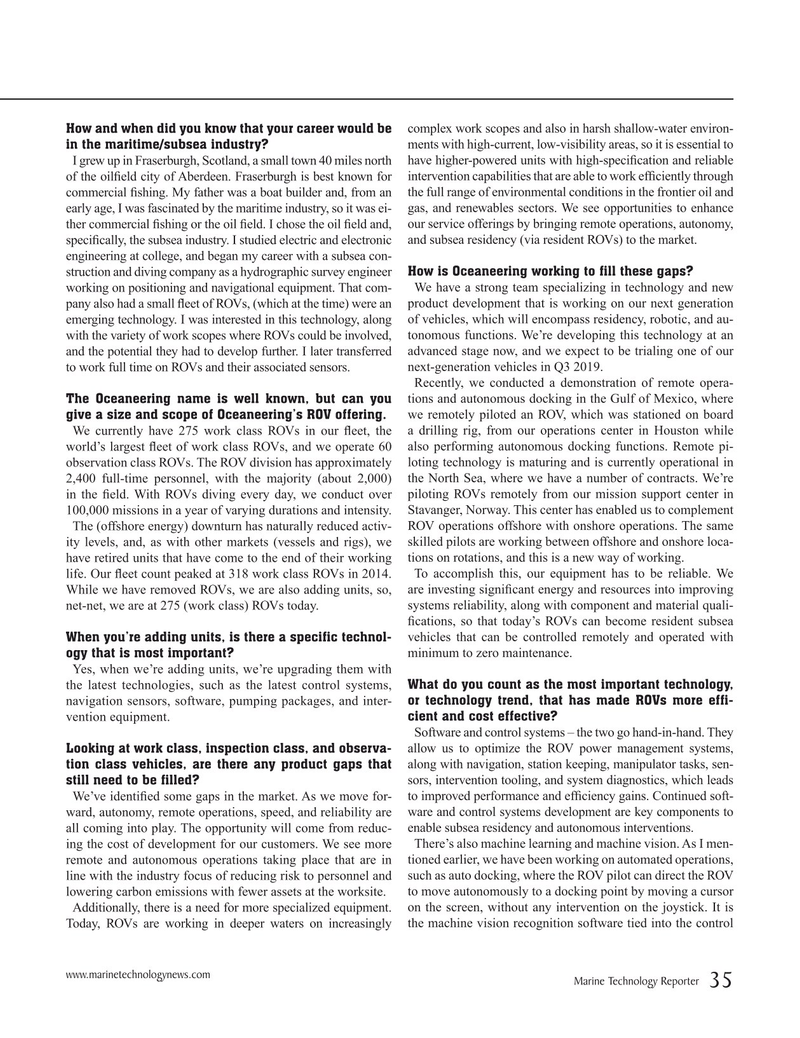
Page 35: of Marine Technology Magazine (March 2019)
Oceanographic Instrumentation: Measurement, Process & Analysis
Read this page in Pdf, Flash or Html5 edition of March 2019 Marine Technology Magazine
How and when did you know that your career would be complex work scopes and also in harsh shallow-water environ- in the maritime/subsea industry? ments with high-current, low-visibility areas, so it is essential to
I grew up in Fraserburgh, Scotland, a small town 40 miles north have higher-powered units with high-speci? cation and reliable of the oil? eld city of Aberdeen. Fraserburgh is best known for intervention capabilities that are able to work ef? ciently through commercial ? shing. My father was a boat builder and, from an the full range of environmental conditions in the frontier oil and early age, I was fascinated by the maritime industry, so it was ei- gas, and renewables sectors. We see opportunities to enhance ther commercial ? shing or the oil ? eld. I chose the oil ? eld and, our service offerings by bringing remote operations, autonomy, speci? cally, the subsea industry. I studied electric and electronic and subsea residency (via resident ROVs) to the market.
engineering at college, and began my career with a subsea con- struction and diving company as a hydrographic survey engineer How is Oceaneering working to ? ll these gaps?
working on positioning and navigational equipment. That com- We have a strong team specializing in technology and new pany also had a small ? eet of ROVs, (which at the time) were an product development that is working on our next generation emerging technology. I was interested in this technology, along of vehicles, which will encompass residency, robotic, and au- with the variety of work scopes where ROVs could be involved, tonomous functions. We’re developing this technology at an and the potential they had to develop further. I later transferred advanced stage now, and we expect to be trialing one of our to work full time on ROVs and their associated sensors. next-generation vehicles in Q3 2019.
Recently, we conducted a demonstration of remote opera-
The Oceaneering name is well known, but can you tions and autonomous docking in the Gulf of Mexico, where give a size and scope of Oceaneering’s ROV offering. we remotely piloted an ROV, which was stationed on board
We currently have 275 work class ROVs in our ? eet, the a drilling rig, from our operations center in Houston while world’s largest ? eet of work class ROVs, and we operate 60 also performing autonomous docking functions. Remote pi- observation class ROVs. The ROV division has approximately loting technology is maturing and is currently operational in 2,400 full-time personnel, with the majority (about 2,000) the North Sea, where we have a number of contracts. We’re in the ? eld. With ROVs diving every day, we conduct over piloting ROVs remotely from our mission support center in 100,000 missions in a year of varying durations and intensity. Stavanger, Norway. This center has enabled us to complement
The (offshore energy) downturn has naturally reduced activ- ROV operations offshore with onshore operations. The same ity levels, and, as with other markets (vessels and rigs), we skilled pilots are working between offshore and onshore loca- have retired units that have come to the end of their working tions on rotations, and this is a new way of working.
life. Our ? eet count peaked at 318 work class ROVs in 2014. To accomplish this, our equipment has to be reliable. We
While we have removed ROVs, we are also adding units, so, are investing signi? cant energy and resources into improving net-net, we are at 275 (work class) ROVs today. systems reliability, along with component and material quali- ? cations, so that today’s ROVs can become resident subsea
When you’re adding units, is there a speci? c technol- vehicles that can be controlled remotely and operated with ogy that is most important? minimum to zero maintenance.
Yes, when we’re adding units, we’re upgrading them with the latest technologies, such as the latest control systems, What do you count as the most important technology, navigation sensors, software, pumping packages, and inter- or technology trend, that has made ROVs more ef? - vention equipment. cient and cost effective?
Software and control systems – the two go hand-in-hand. They
Looking at work class, inspection class, and observa- allow us to optimize the ROV power management systems, tion class vehicles, are there any product gaps that along with navigation, station keeping, manipulator tasks, sen- still need to be ? lled? sors, intervention tooling, and system diagnostics, which leads
We’ve identi? ed some gaps in the market. As we move for- to improved performance and ef? ciency gains. Continued soft- ward, autonomy, remote operations, speed, and reliability are ware and control systems development are key components to all coming into play. The opportunity will come from reduc- enable subsea residency and autonomous interventions. ing the cost of development for our customers. We see more There’s also machine learning and machine vision. As I men- remote and autonomous operations taking place that are in tioned earlier, we have been working on automated operations, line with the industry focus of reducing risk to personnel and such as auto docking, where the ROV pilot can direct the ROV lowering carbon emissions with fewer assets at the worksite. to move autonomously to a docking point by moving a cursor
Additionally, there is a need for more specialized equipment. on the screen, without any intervention on the joystick. It is
Today, ROVs are working in deeper waters on increasingly the machine vision recognition software tied into the control www.marinetechnologynews.com
Marine Technology Reporter 35
MTR #2 (34-49).indd 35 3/11/2019 11:29:34 AM

 34
34

 36
36
